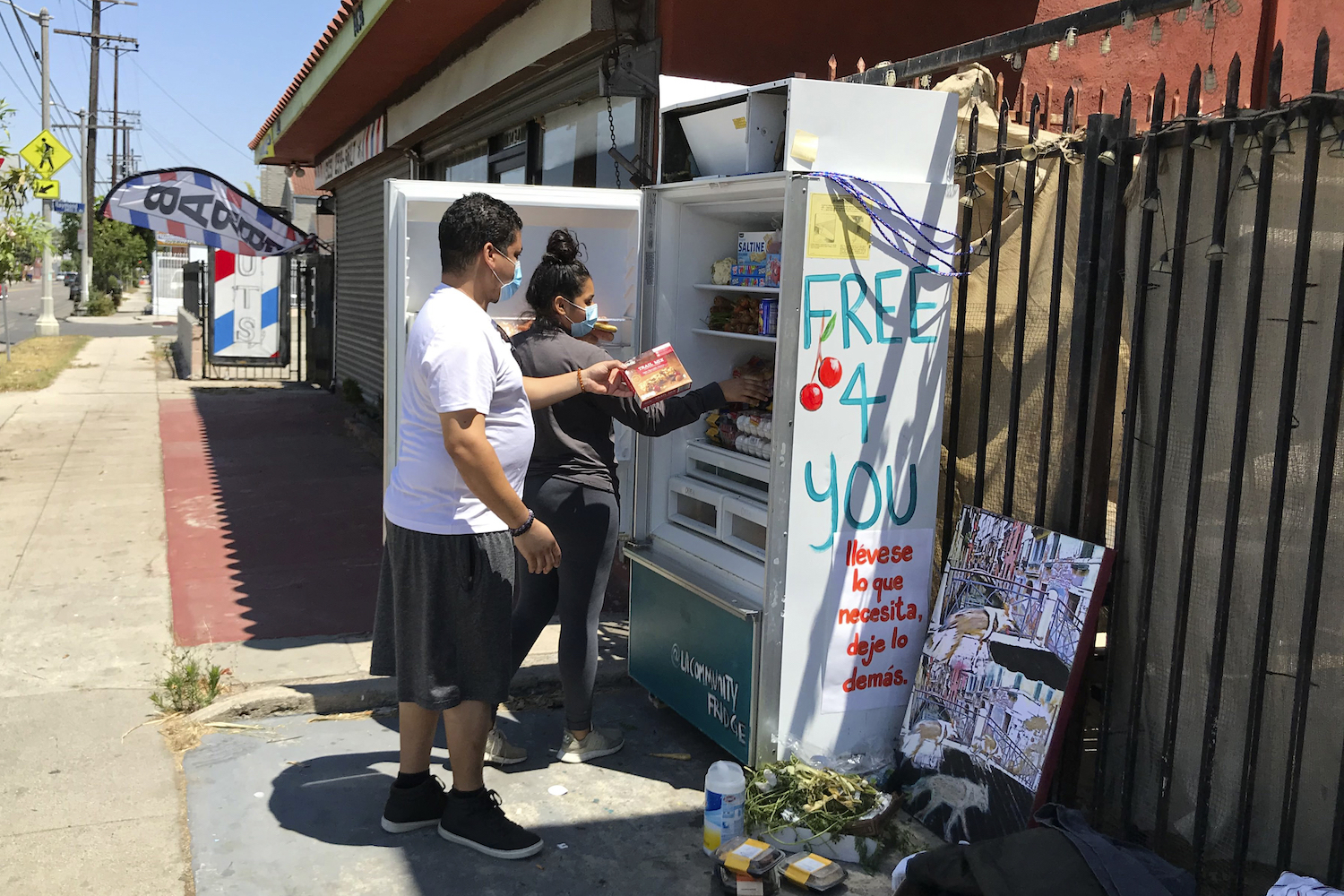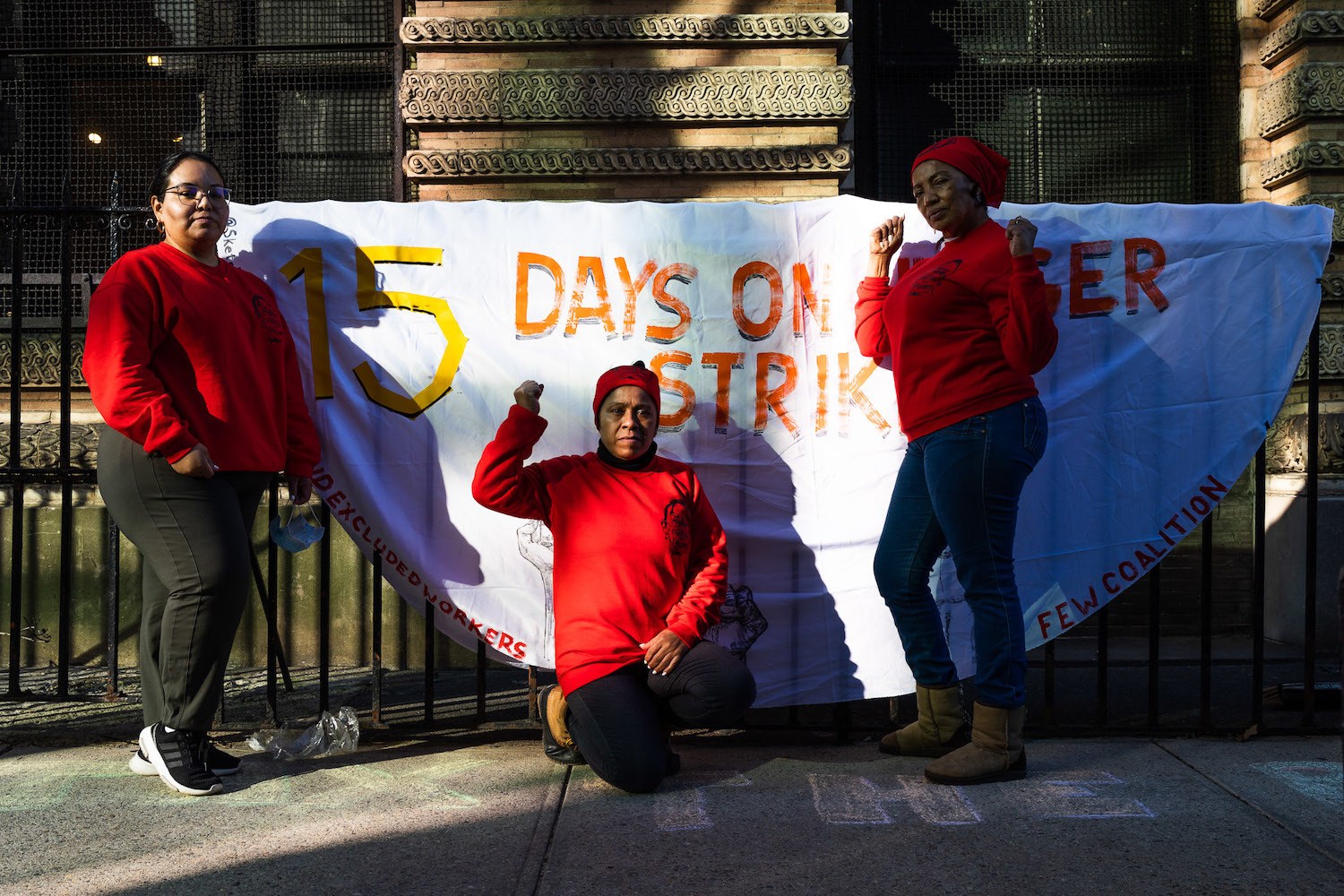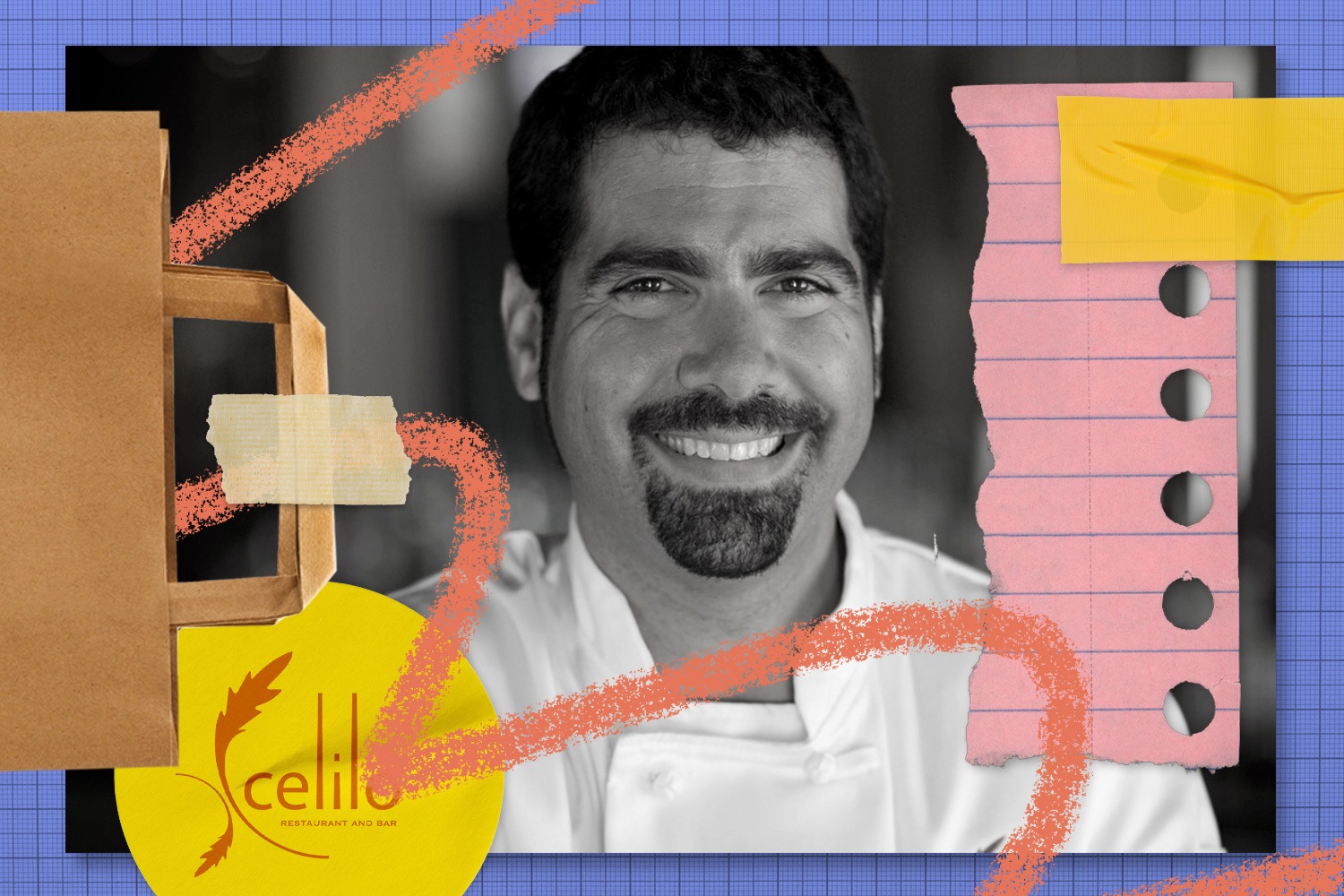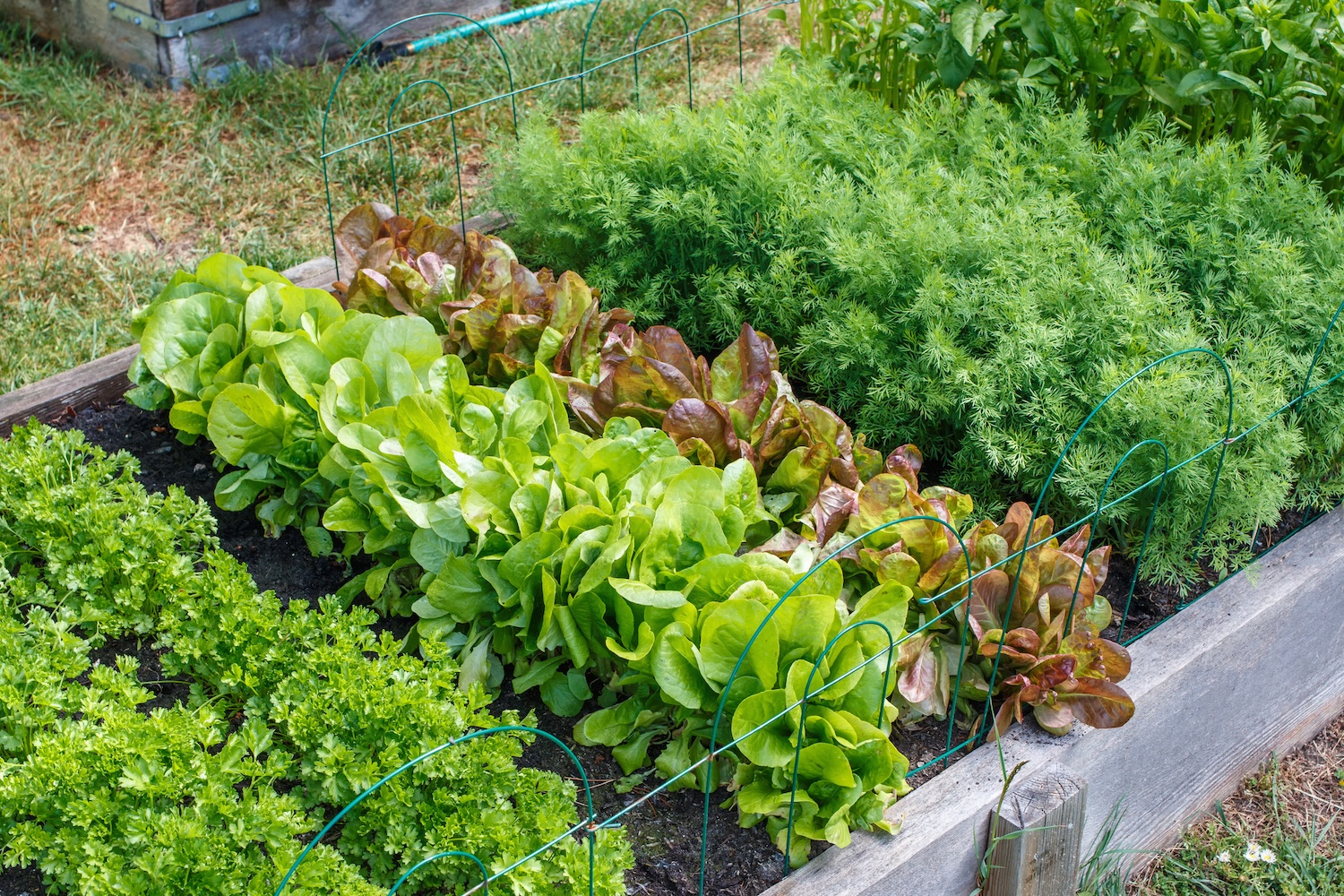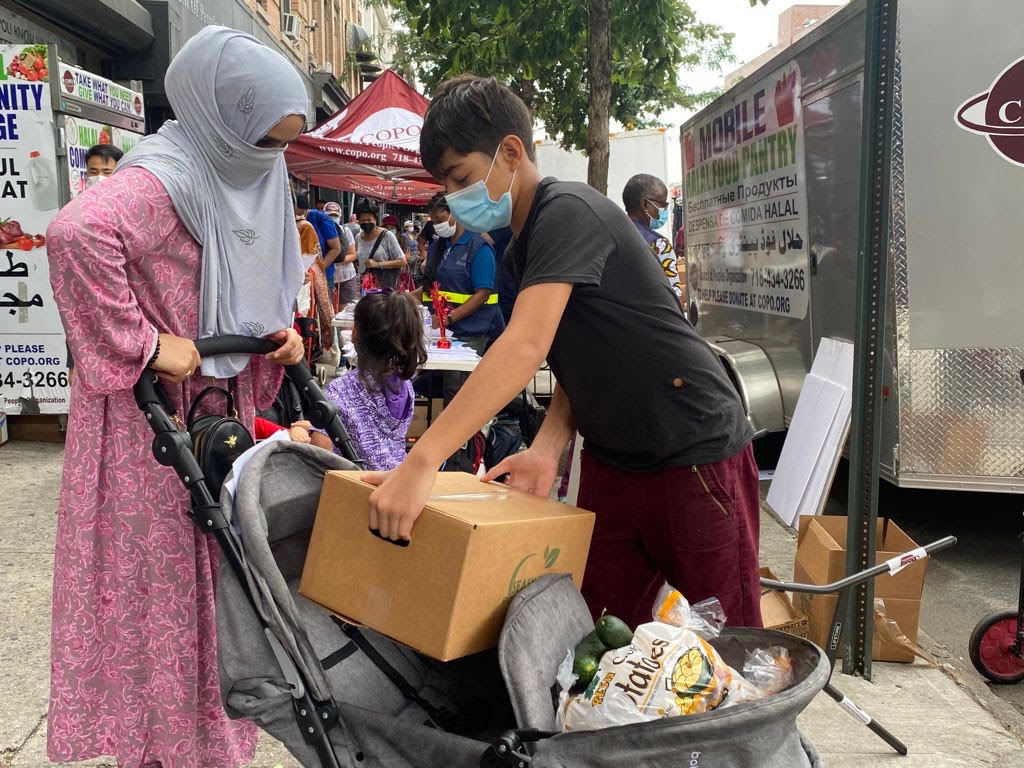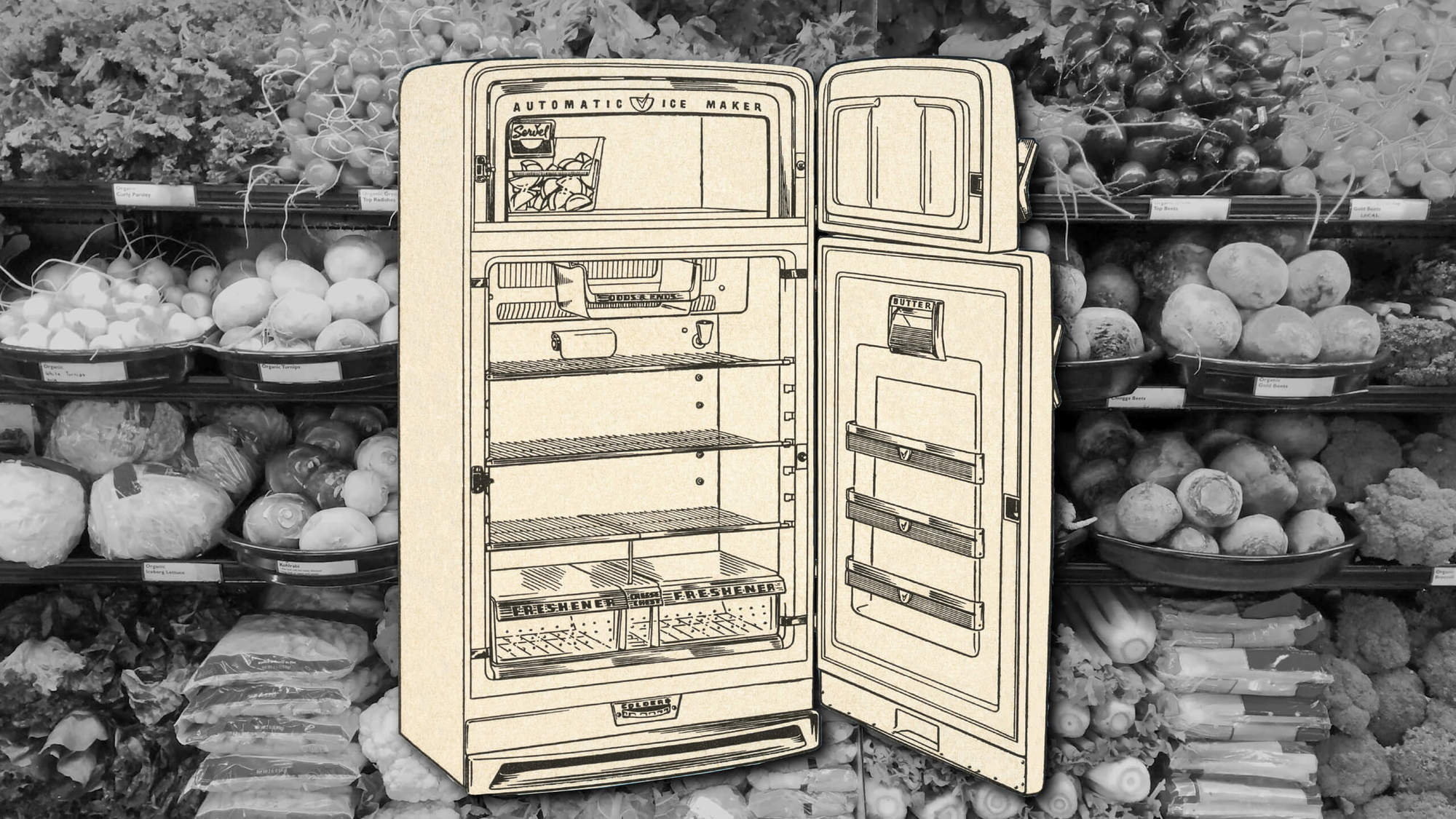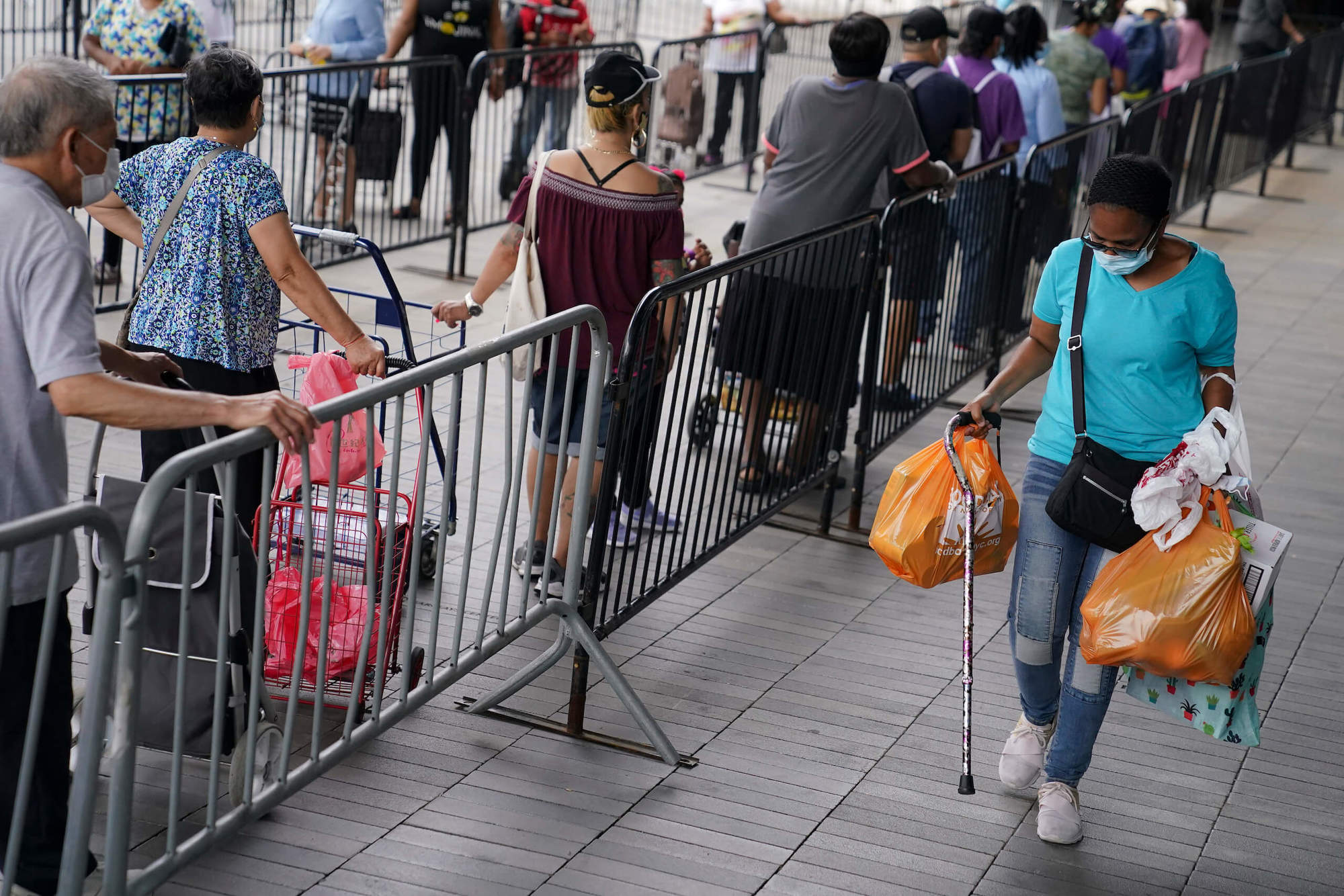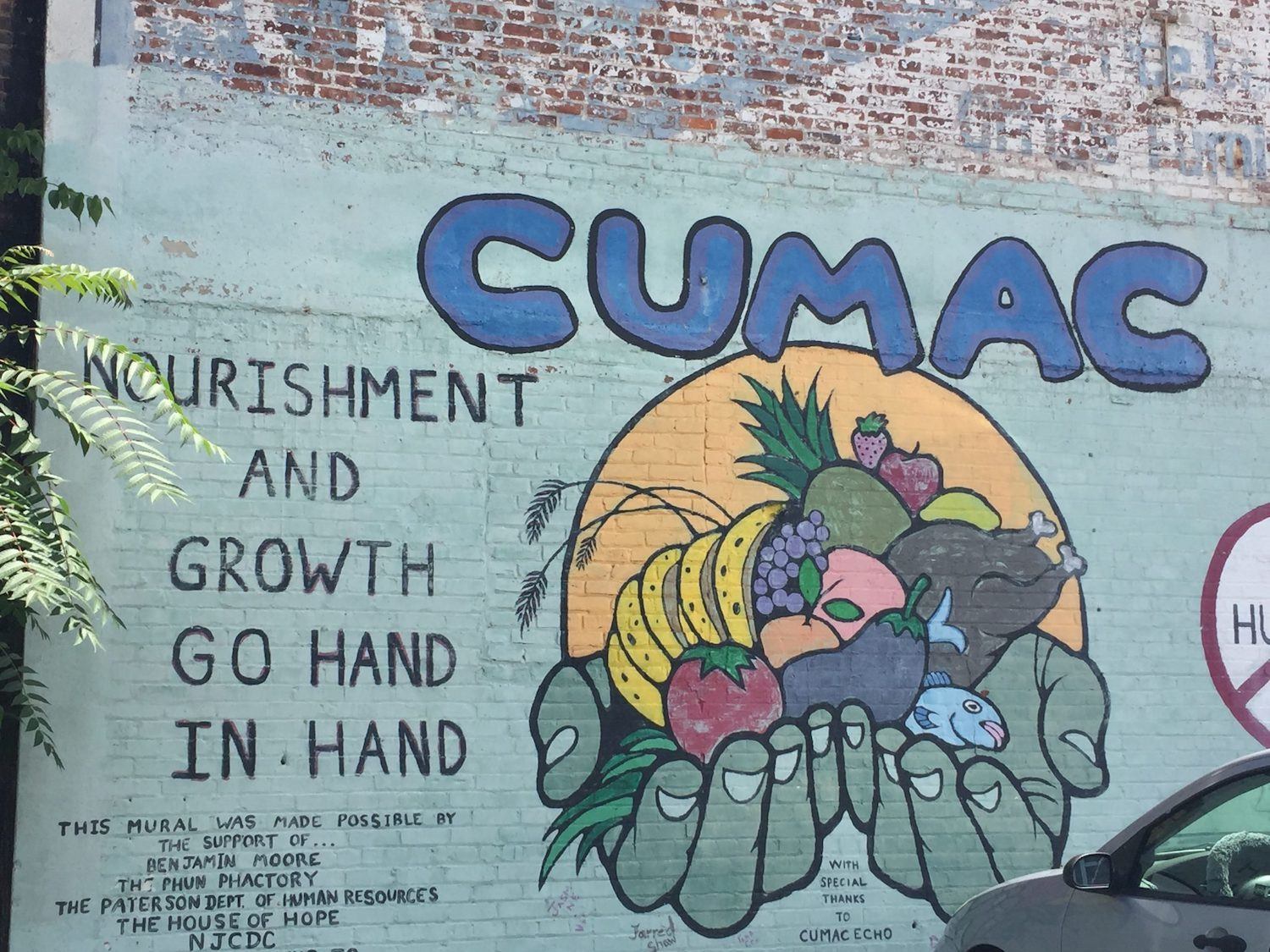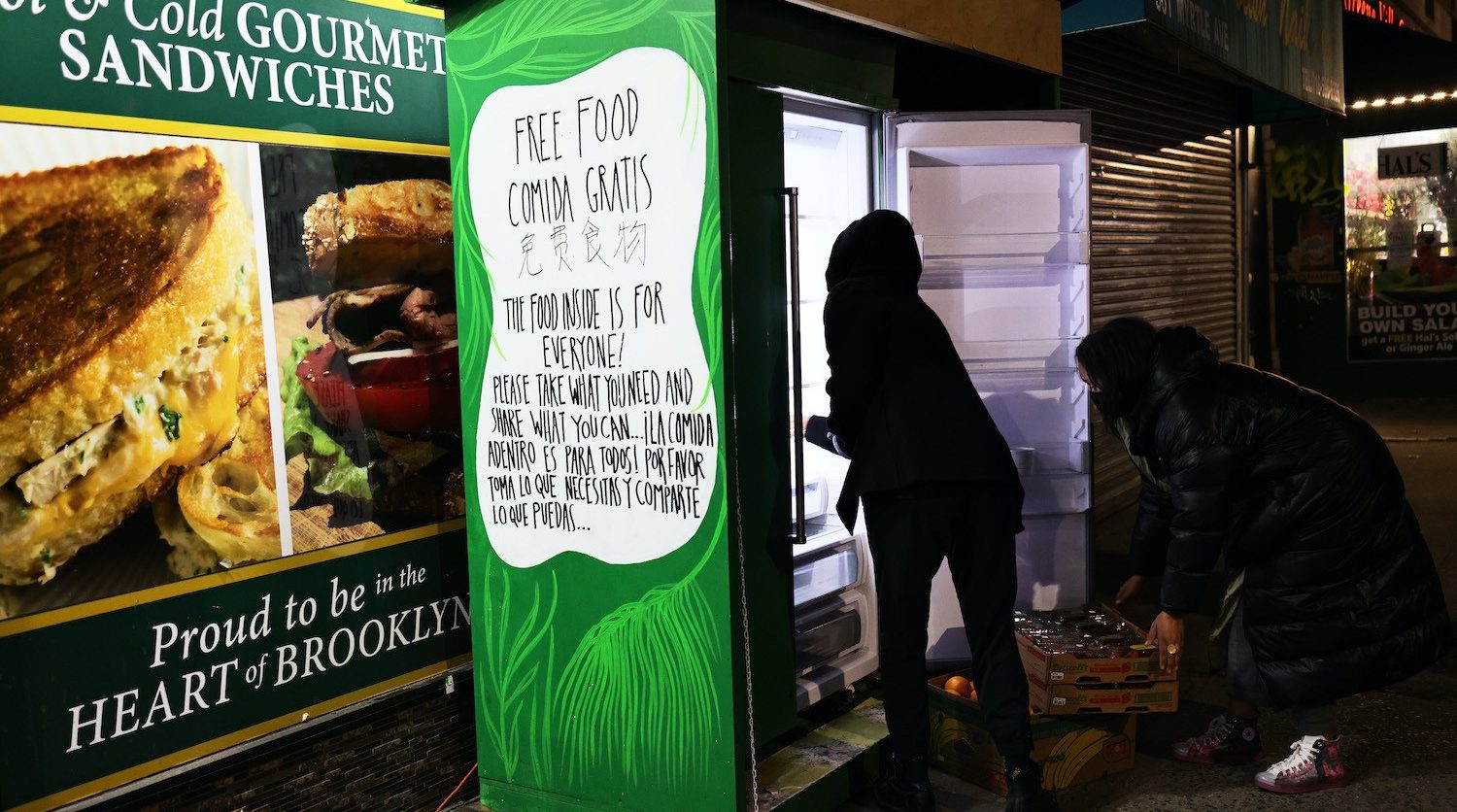
Michael M. Santiago/Getty Images
Despite logistical hurdles and pushback from city officials, organizers are making it their mission to protect community fridges, which have transformed into a combination of social hubs and distribution centers aimed at making sure everyone has access to food.
The Friendly Fridge BX, below the last 1 train stop in the Bronx, is impossible to miss. Cardboard boxes and milk crates overflowing with loose sweet potatoes, corn, garlic scapes and heads of cabbage regularly extend into the sidewalk from a forest green shed, where inside sits a fridge, painted yellow, orange and sky blue, with a raised green fist grasping a carrot.
Depending on the time of day, pulling open the door can reveal a kaleidoscopic spread of plastic clamshells stuffed with berries or sliced watermelon, an entire row of heads of lettuce—even prepared meals of chicken and rice from Best Deli & Grill down the block. Come an hour later, and it might all be gone. Written in English and Spanish on the shed is the mantra “take what you need, leave some for others.” For over a year, thousands have come to depend on this philosophy to put food on their tables.
Community fridges like the Friendly Fridge BX long predate the pandemic, having been scattered from California to Texas to Arkansas as isolated projects. But over the past 19 months, in the wake of mass unemployment and faltering emergency food systems, the concept has exploded across the U.S. as a broad grassroots movement aimed at combating food insecurity on local levels. Hundreds of fridges adorned in bright colors have begun popping up outside restaurants and delis, houses of worship and people’s homes, all promising free food to those who need it.
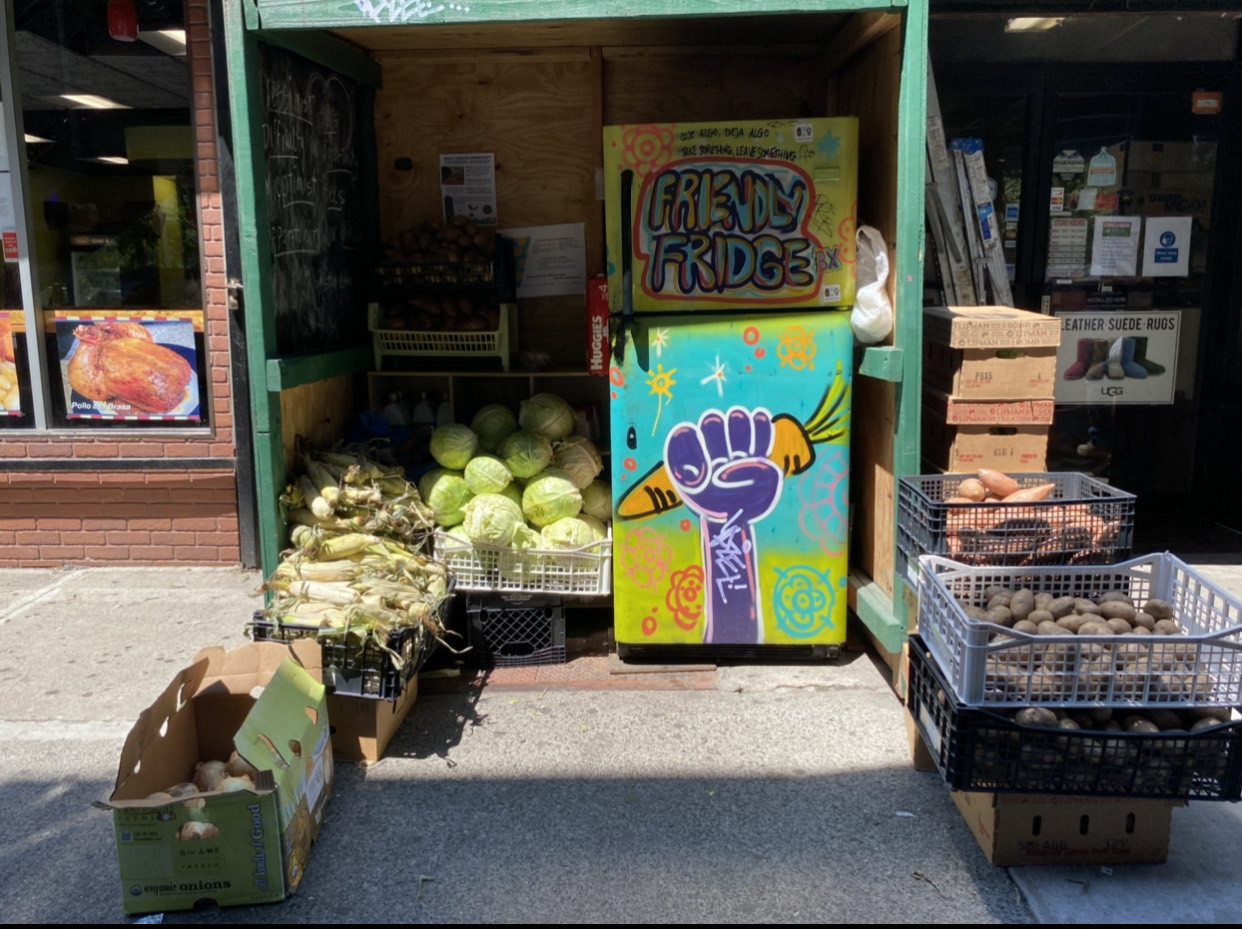
Sara Allen and her wife, Selma Raven, started the Friendly Fridge BX in May 2020. They said no one in their community believed the fridge would last and now, one-time skeptics are dropping off prepared dishes regularly.
Courtesy of The Friendly Fridge BX
This continued demand for community fridges is not surprising. The Department of Agriculture (USDA) announced in an annual report that the percentage of American households that were food insecure, or had difficulty providing food for every household member at some point due to a lack of money, remained unchanged in 2020 compared to the previous year. But researchers told The Counter that the government’s expansion of nutritional and financial aid, together with increased food assistance via charitable and mutual aid organizations, was vital in preventing the spread of hunger.
An analysis by Feeding America found that at least 60 million people relied on food banks and other private food assistance programs last year, a 50 percent increase from 2019, and more than 1.5 times the number of people classified as food insecure in 2020 by USDA. And even with the economy on track for recovery, hunger has persisted, particularly in marginalized communities. A recent survey by the U.S. Census Bureau found that 12.3 percent of Black and 11.5 percent of Latino respondents reported sometimes or often not having enough food to eat, compared to 5.6 percent of white respondents.
“Recovery is very spotty, and many workers in the food sector are still really struggling, and immigrant communities, communities of color have not fully recovered,” said Nicholas Freudenberg, Senior Faculty Fellow at CUNY Urban Food Policy Institute. “There will continue to be serious levels of food insecurity at least for the next couple years.”
Many fridges have entrenched themselves as part of their neighborhoods’ fabric, and volunteers hope that even amid the uncertainty surrounding the pandemic, these efforts will continue to provide an avenue for food access for their neighbors.
But while these outdoor appliances have proliferated as a combination of food distribution and social hubs in their communities, so too have the challenges surrounding their maintenance and continuation. Volunteers and organizers have had to navigate logistical headaches, including the spike in size of food donations and erratic pickup schedules, while a number of these units have endured volunteer shortages and burnout.
Many fridges, however, have entrenched themselves as part of their neighborhoods’ fabric, and volunteers hope that even amid the uncertainty surrounding the pandemic, along with pushback from wealthier neighbors or government officials, these efforts will continue to provide an avenue for food access for their neighbors.
Sara Allen, a programmer and a co-founder of the Friendly Fridge BX, said that people are “showing up because they need the help, they need to make that extra medical bill that they couldn’t pay, they need to make that extra mortgage payment.”
“We’re not getting away from this very quickly.”
—
When Allen and her wife, Selma Raven, started the Friendly Fridge BX last year in May, in the middle of a global pandemic, the pair said no one—not the cabbies parked on Broadway, not the employees at the pizzeria at the end of the block, not the guys at the bodega few stores over—believed the fridge would last in their community, much less have an impact.
After seeing on Instagram that a friend in Harlem started her own community fridge, the pair secured a fridge off Craigslist. They filled the fridge modestly at first, using $10 and $20 donations from friends to buy produce and sandwiches from street vendors and local shops, and posted images of the bounty on Instagram. Neighbors started taking note, with some making regular trips to grab food to eat, and others dropping off a few pounds at a time of garlic scapes and eggplants from their CSA, and a number reaching out to volunteers. Within a year, the fridge had grown from a two-person operation on Broadway into a loose constellation of volunteers and donors, processing thousands of pounds of groceries and meals that fed hundreds of people every week.
“One of the goals is to be able to really be food secure. That’s very hard because we are depending on donations.”
One-time skeptics from the bodega are now dropping off hot prepared dishes for the Friendly Fridge BX, while Jose Escobar of Broadway Joe’s Pizza stops by during slow periods at the shop to help with processing donations. Lilliam Aponte, who first began to use the fridge after getting laid off from her job as a home attendant, now cleans it three times a day for a stipend, and Larry Levine, a volunteer, is called upon for his Chrysler and Chevy—and for larger loads, a U-Haul rental van—to procure boxes of canned and dry goods or fresh produce from pantries like 9 Million Reasons, and hundreds of pounds of breads from local bakeries like Orwashers. Monetary donations, which have cleared $47,000 through a rolling GoFundMe campaign, continue to be pumped back into the community businesses to pay for food for the fridge or to provide for gas for the drivers’ pick-ups.
“We probably get on an average of two to three larger drops a day, and by larger we’re talking 350 to even 700 pounds each drop, and those drops empty out in about an hour and a half,” said Allen. “But that’s also not counting the different families that drop by with an extra bag of food, someone moving out and they drop by with two bags, so I would say we probably move at an average of 1,000 pounds a day.”
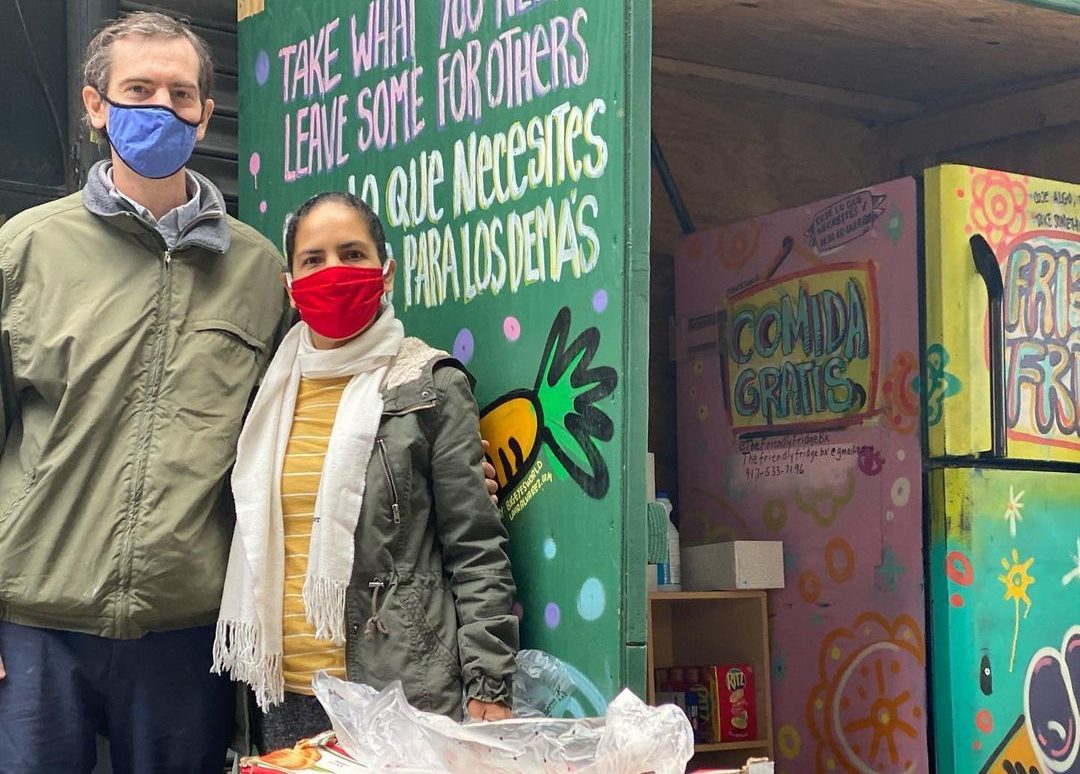
Volunteers Celi and Taylor drove to 9 Million Reasons, loaded up their car and transported everything to The Friendly Fridge BX in April 2021.
thefriendlyfridgebx / Instagram
But the logistics of running a project with the twin goals of reducing food insecurity and waste continue to be perplexing. Bakeries across town might call at 10 p.m. with hundreds of pounds of food that will be dumped if it’s not picked up in 30 minutes. On some occasions, it’s unclear whether there will be any food deliveries the next day.
“One of the goals is to be able to really be food secure,” Raven, a special education teacher, said about the fridge. “We need to know that every Monday, Wednesday, Friday, there’s going to be prepared meals. Every Thursday and Saturday, it’s going to be bread and milk. That’s very hard because we are depending on donations.”
—
The organizations behind community fridges often consider themselves practitioners of mutual aid, where communities organize and take on the responsibility of supporting one another, often through the exchange of goods and services, rather than leaving individuals to fend for themselves. Many of these groups also see their projects as a rejection of the nonprofit world, where the bureaucracy of boards of directors and requirements of grants can slow down the process or even exclude those they’re supposedly trying to help, as well as traditional charity organizations, which unlike mutual aid are one-directional in who benefits and do not aim to address the root causes of inequality, according to critics.
“People are very protective of the fridge and really see it as an asset to the community, and are some of those folks who hang out there on a regular basis. They really value having this resource and they want to make it better.”
But for some of the organizers and their community fridge networks, trying to operate according to this ideological framework is seen as much more of a hindrance to the mission of getting food to those in need than an asset. One concern, for example, is potentially turning off foundations or companies that would not be able to get tax write-offs for donating to an organization that isn’t formalized as a nonprofit.
Daniel Zauderer, a former charter school teacher who helped cofound the Mott Haven Fridge network, sees the decision to transition his organization into a nonprofit as crucial to both its efficacy in its objective to feed the hungry and the project’s longevity.
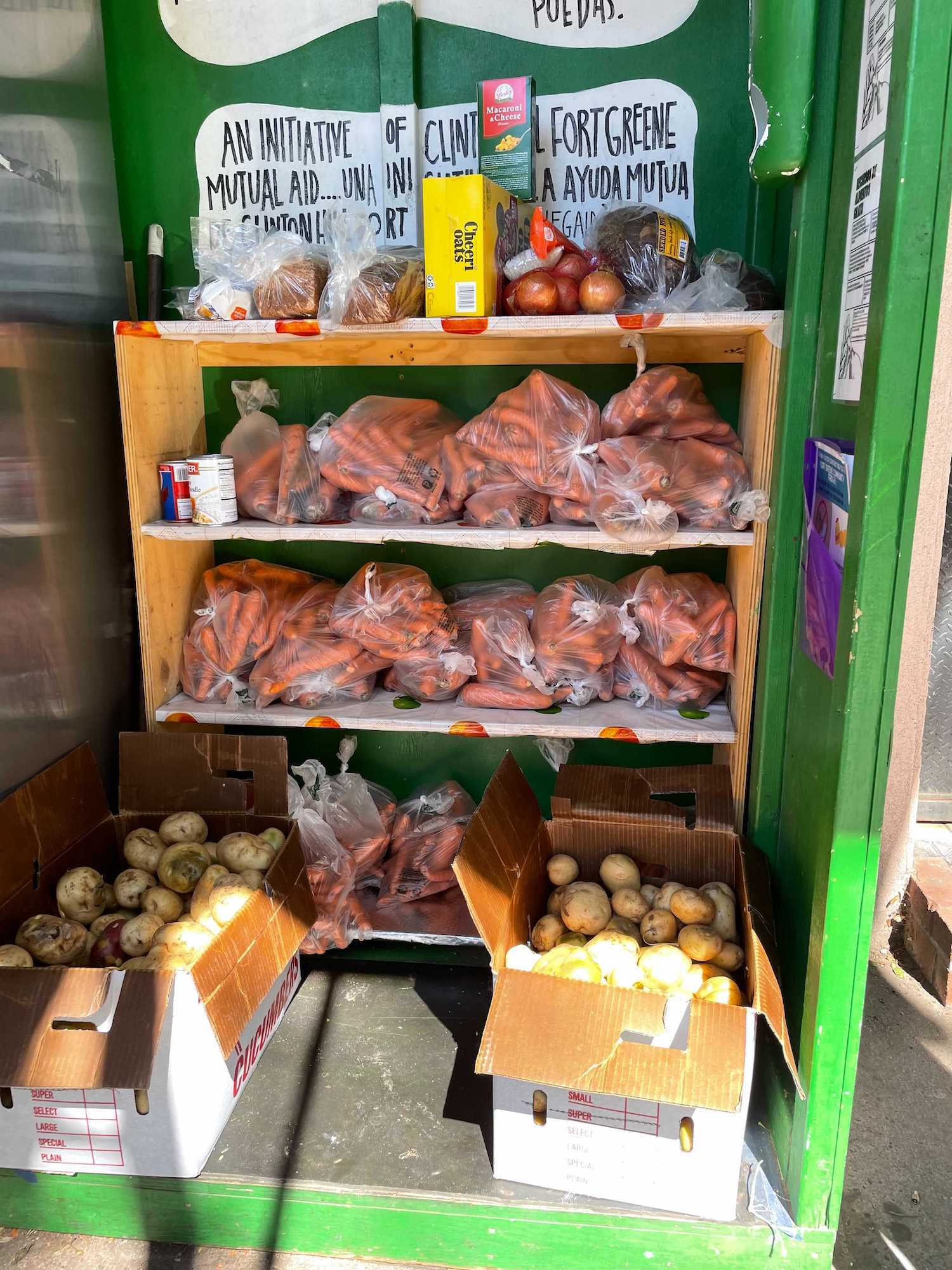
Sam Pawliger / Fort Greene Community Fridge
At the Fort Greene Community Fridge in Brooklyn, volunteers say that the same people who rely on the fridge for their daily meals, or to fill their own fridges and pantries at home, have also helped maintain the space and used it as a place to connect with their neighbors.
“I think people are going to realize mutual aid initiatives were fads of the pandemic because they didn’t have the staying power—because they weren’t able to figure out a way to formalize or systematize what they were doing,” Zauderer said, adding, “I think it’s super important to find a way to be scalable if you really want to make an impact.”
Several organizers note that fridges that have been most effective over time have not only offered a means to ensure community members have access to food that they need, but have also been embraced by those who engage with their fridges as social hubs. At the Fort Greene Community Fridge in Brooklyn, volunteers say that the same people who rely on the fridge for their daily meals, or to fill their own fridges and pantries at home, have also helped maintain the space and used it as a place to connect with their neighbors.
“People are very protective of the fridge and really see it as an asset to the community, and are some of those folks who hang out there on a regular basis,” said Sam Pawliger, a volunteer with the Fort Greene fridge. “They really value having this resource and they want to make it better.”
—
On a recent August afternoon just before four, the Friendly Fridge BX was overflowing with packages of neon orange zig-zag-cut butternut squash, frozen burger patties and sweet Italian sausages, bags of onions, heads of cabbage, corn, and shiny green bell peppers—much of the haul having made its way from the food rescue organization City Harvest. A stream of regulars immediately began stopping by, opening the fridge and freezer doors dozens of times to see what could be used to prepare that night’s dinner, while also chatting with the organizers.
Ramiro Martinez, a dishwasher who stops by the fridge twice a day, grabbed potatoes to mash as well as a pepper, while Paulette McIntosh, a nursing assistant who came by with a coworker on her way to BJ’s Wholesale Club, picked out corn and onions. Rossy Martinez, a new mother who in May started a job as a bookseller after two years of unemployment, took home a canvas bag full of frozen sausages and potatoes.
But while several fridges have become established community resources, ensuring that there are enough volunteers to maintain them has become an ongoing challenge for organizers, with many restrictions having been lifted and people continuing to return to work.
“There’s a lot of people that need this, a lot of people that were laid off or haven’t been working from the pandemic and they’d benefit from some of this food as well,” Martinez said. “More fridges should open up around here. People should be more aware and keep the area clean so we could provide to others.”
But while several fridges have become established community resources, ensuring that there are enough volunteers to maintain them has become an ongoing challenge for organizers, with many restrictions having been lifted and people continuing to return to work.
Kira Morrison, a music teacher and children’s performer who volunteers with the Los Angeles Community Fridges network, said that some people who were previously on unemployment while helping with the fridges are now working 9-to-5 jobs, and jumping straight from their work shifts into scheduling donation pick-ups and cleaning sign-ups. This is leading to burnout.
Organizers at the Los Angeles Community Fridges network are working to soften the burden on volunteers, according to Morrison, including making slides for volunteer orientation on recognizing burnout and reminding people to take breaks and turn off Slack messages from the group’s workspace. She added that proactively recruiting new volunteers into the mix could help ensure the fridges’ future.
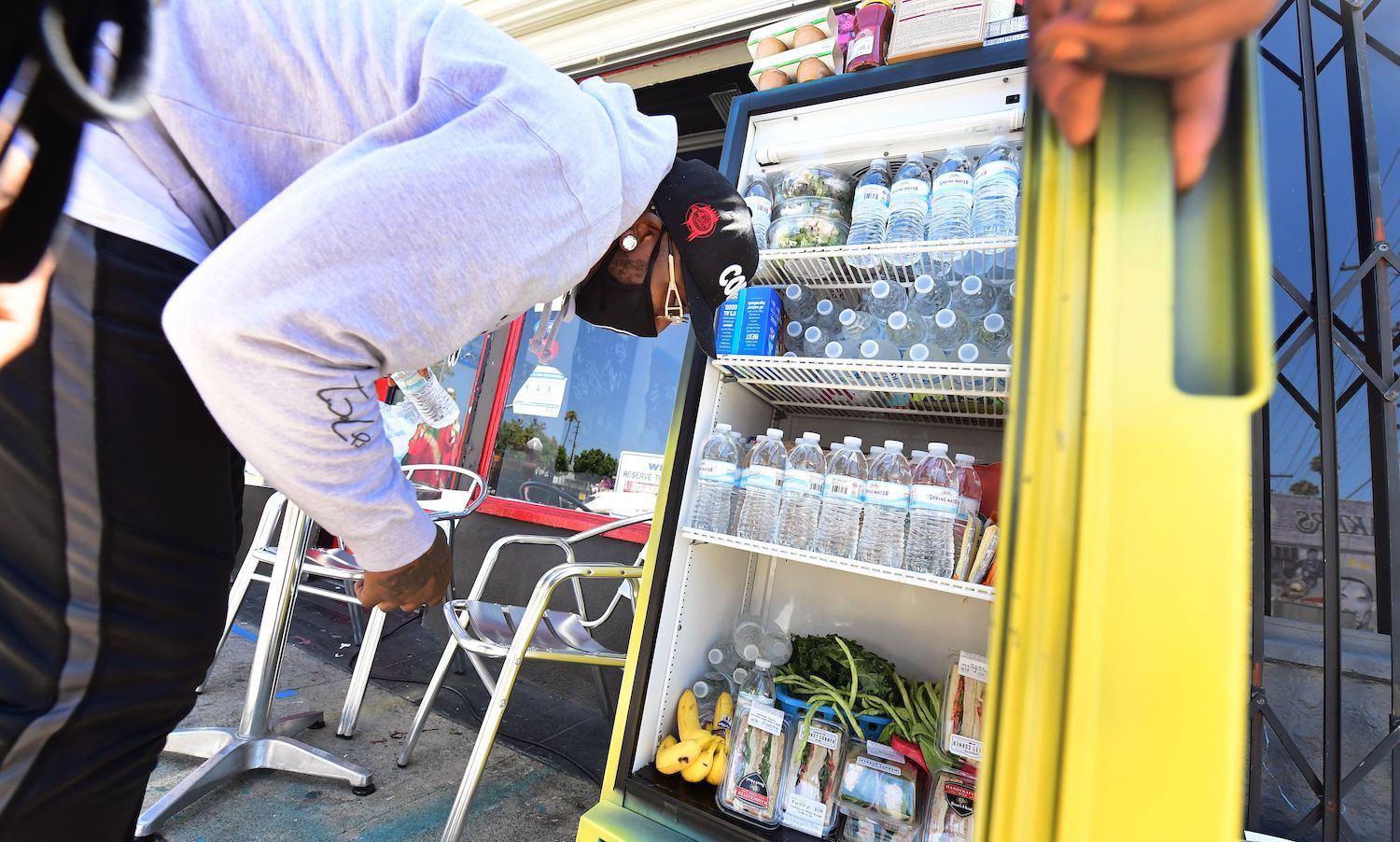
Solo Morris holds the fridge door open as Danny Dierich stocks it with more items outside the Little Amsterdam Coffee shop in Los Angeles, California.
FREDERIC J. BROWN/AFP via Getty Images
“I have a lot of friends who live in Eagle Rock and they need a lot of volunteers to clean, so I texted my friends and I’m like, ‘Hey, you’ve never done this, but would you want to clean a fridge once a week?’” Morrison said, referring to a neighborhood in Los Angeles. “So more people are sharing the burden instead of just a small group of people.”
Many organizers agreed that a wide body of volunteers is necessary for the survival of these fridges. Zauderer of the Mott Haven Fridge, in describing a steady expansion over time of the fridges tied to his network, emphasized a need to continue attracting volunteers, both in terms of those committed to supporting already-established fridges, along with those interested in bringing a new fridge into their community.
“We hope that future fridges that come up into our network are through volunteers that are recruited with that specific fridge,” he said.
Others, like the Fort Greene Community Fridge, have adapted to accommodate the volunteer shortage, an issue that emerged this past summer as people left the city for vacation.
“We’ve reduced some donation pick-ups in terms of frequency and we’re just kind of rolling with the schedules that we are able to fill.”
“We’ve reduced some donation pick-ups in terms of frequency and we’re just kind of rolling with the schedules that we are able to fill,” Pawliger said. “And if we don’t have someone to pick up a donation that day, then unfortunately we just don’t have someone to pick it up.”
Challenges to fridges’ future go beyond just ensuring these grassroots food exchange hubs are maintained and kept well-stocked. Fridges set up with restaurants or other commercial businesses as their electrical hosts run the risk having their cords cut—literally in some cases—when the business is sold or if the landlord decides to terminate the partnership with the fridge; others that are run outside of people’s residential homes technically in violation of zoning regulations have been shut down following complaints from neighbors; and, of course, reports of vandalism, destruction or theft abound. This past September, just days after the Mott Haven Fridge network celebrated its first year serving the neighborhood with a community brunch, its fridge and pantry on St. Ann’s Avenue were found knocked over, and the electricity cord cut.
But organizers do not go quietly after a fridge is unplugged for good. In many cases, operators quickly begin to put out calls on social media and reach out across the community to find a new partner willing to host their appliance.
Jacob deBlecourt, a volunteer with the Allston/Brighton Community Fridges in the Greater Boston area, explained that when their Allston community fridge was unplugged by the restaurant’s landlord earlier this year, their organization spent weeks attending meetings, posting fliers and going door to door in pursuit of partnering with a new business or community center. In the end, the group rehomed their fridge at the Brighton Allston Congregational Church.
“When you take away that resource for people, you’re not just taking it away from strangers. You’re taking away from our friends and our family and our neighbors.”
The reason that the group persevered in finding a new host was because the impact of their absence was immediately felt in the community.
“When you take away that resource for people, you’re not just taking it away from strangers,” deBlecourt said. “You’re taking away from our friends and our family and our neighbors.”
As for the Mott Haven fridge, after organizers announced the news of the attack, $2,700 in donations—nearly triple the goal amount—poured in to help with the cost of a new fridge and a shed to house it. Volunteers also showed their support by turning up the day after to distribute donations for the Saturday food drop.
But no matter how much food community fridge volunteers and organizers direct from pantries and local businesses into the arms of their neighbors, there’s an implicit understanding that even in the long-term, their movement is not a silver bullet for addressing the underlying causes driving food insecurity across the nation.
“We’re giving whatever we can in our capacity and that just has to be enough, even though we know there’s no way that we’ll give everyone the food they need and keep every fridge full all the time,” Morrison said. “Everyone should try to do what they can, but I think the people who really need to be feeling that pressure and that weight are the city and the government, who actually are being paid and have funding to actually end this, rather than unpaid volunteers.”

